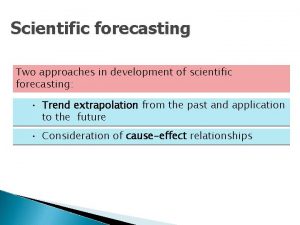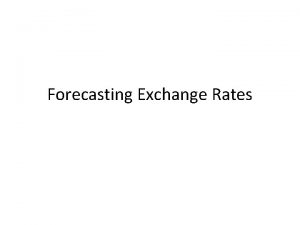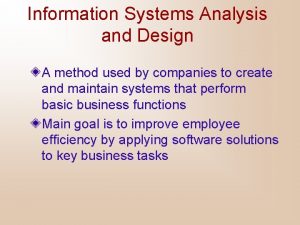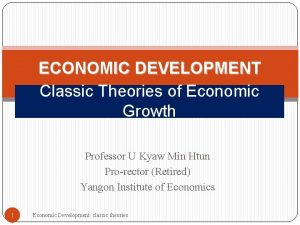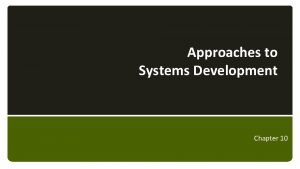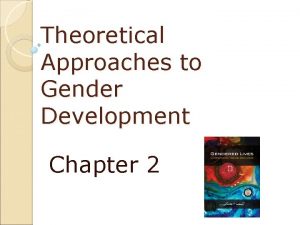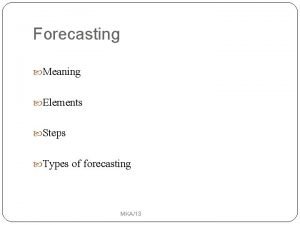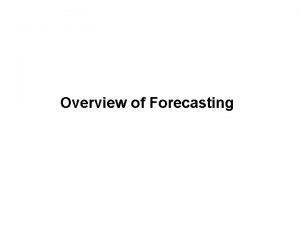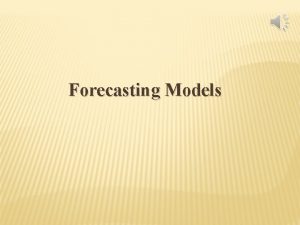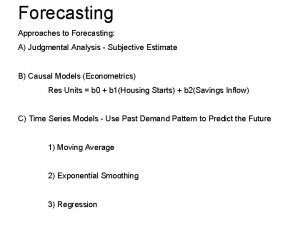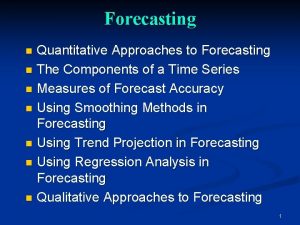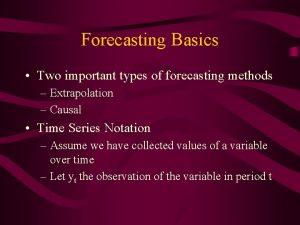Scientific forecasting Two approaches in development of scientific

















- Slides: 17

Scientific forecasting Two approaches in development of scientific forecasting: • Trend extrapolation from the past and application to the future • Consideration of cause-effect relationships

Forecasting model Input § data § intuition FORECASTING METHODLOGY (methods and techniques) Output Predictions

Forecasting methods Exploratory methods Normative methods

Exploratory Methods Alternative futures resulting from the different “histories” Given what we understand about the present, what would we expect to happen if this event happened, this trend developed? WHAT IF…?

Exploratory Methods Exploratory methods essentially begin from the present, and see where events and trends might take us. They begin with the present as the starting point, and move forward to the future, either on the basis of extrapolating past trends or causal dynamics, or else by asking “what if? ” questions about the implications of possible developments or events that may lie outside of these familiar trends.

Normative methods Desirable future PRESENT Other more realistic futures HOW?

Normative methods Normative methods ask what trends and events would take us to a particular future or futures. They start with a preliminary view of a possible (often a desirable) future or set of futures that are of particular interest. They then work backwards to see if and how these futures might or might not grow out of the present – how they might be achieved, or avoided, given available constraints, resource and technologies.

Forecasting methods Quantitative methods Qualitative methods

Quantitative methods rely on numerical representation of developments, data that have been mathematically processed, extrapolation of trends. Quantitative data may come from statistical sources, or be the products of expert judgement.

Quantitative methods It might be more difficult to communicate results (tables and graphs) to less numerate audiences. They allow to examine rates and scales of change but they limit the understanding of many important social and political variables.

Quantitative methods - disadvantages Some issues are difficult to represent in numerical terms The quantifiable elements of a phenomenon do not necessarily represent its essence Too restricted to concepts and indicators, rarely inquire into the dynamics of a phenomenon Some of the advanced statistical methods and modelling techniques have a high degree of complexity that can be difficult to understand

Qualitative methods Qualitative methods are often employed where the key trends or developments are hard to capture via simplified indicators, or where such data are not available. Useful to stimulate creativity and intuition; essential for engagement and dialogue The outcomes are illustrations that describe complex processes and interaction among variables

Narayanan – Forecasting tools Stages of Applicability Time Series Objective Quantitative Growth/Maturity S - curves Objective Quantitative Growth/Maturity Simulation Objective Quantitative Business situation Scenario Mixed Quantitative and Wide applicability judgmental Delphi Subjective Qualitative Early stage technology Morphological analysis Objective Quantitative Developing new products, processes, or materials

Forecasting model Input § data § intuition FORECASTING METHODLOGY (methods and techniques) Output Predictions Quantitative data Qualitative data Time Probability

Output of forecasting Quantitative data Qualitative data Time Probability

Important criteria in selecting the method Accuracy of methods Available data Time horizon Costs Simplicity in application

Summary remarks There are good reasons for using formal technology forecasting methods Multiple criteria are used for selecting methods No easy classification – methods may be used and combined together Consequently, there are no recipe books for doing foresight – different combinations are likely to be needed for different circumstances
 What are the two types of forecasting
What are the two types of forecasting Fundamental forecasting of exchange rates
Fundamental forecasting of exchange rates Approaches to systems development
Approaches to systems development Dualistic development thesis
Dualistic development thesis Approaches to systems development
Approaches to systems development Psychodynamic theories definition
Psychodynamic theories definition Four approaches to employee development
Four approaches to employee development Self-help approach in community development examples
Self-help approach in community development examples Critical period vs sensitive period
Critical period vs sensitive period What are the two types of forecasting
What are the two types of forecasting Principle based corporate governance
Principle based corporate governance The two dominant agile approaches are
The two dominant agile approaches are Information gathered during an experiment
Information gathered during an experiment How is a scientific law different from a scientific theory?
How is a scientific law different from a scientific theory? What is the history of community development in tanzania?
What is the history of community development in tanzania? Development that ended much development crossword
Development that ended much development crossword Development of a cylinder
Development of a cylinder Managerial judgement method
Managerial judgement method
